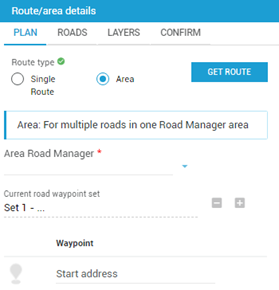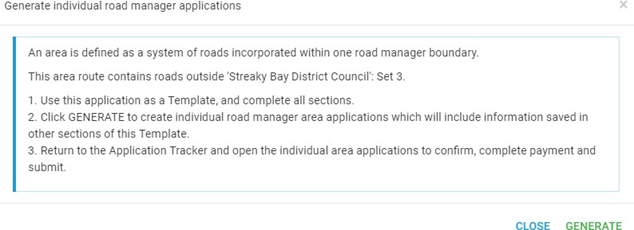Area Application
Watch the Route Planner video.
- Select Step 3 Route.
- Select Plan tab.
- Select Area.
Use a Previous Route/ Existing Route
- Click Get Route to use a previous route (Journey Planner or Route Planner).
- Enter Route ID.
- Click Load Route.
Area applications are made up of a number of short road sections that connect from/ to an approved network. These are Road Waypoint Sets, with each set having a start and end point. Turn on the Network Layers to view the approved network for the vehicle.
New Area Application within a single Road Manager boundary
- Select the Plan tab.
- Enter or select Area Road Manager using drop-down (if known).
- If not known, add Waypoints in the field or use the drop-pin on the map. The Area Road Manager will populate based on the first waypoint location.
Select the drop-pin, click to blue for ON / or black for OFF
- The approved network will display.
- Map the route.
- Enter the start and end address for each waypoint set or use the drop-pin to add new road sections to your area.
- The route will display on the interactive map.
- A Route Id will be automatically assigned (this can be reused on other permit applications).
- Rollover any point on the route to Drag and Drop a waypoint.
- Delete any waypoint using trash or edit the waypoint to change the waypoint label, or delete the Road Waypoint Set.
- Drawing and measuring tools are also available (bottom left of the map display).
- If the route is not displaying, click recalculate.
When editing or deleting a drawing line or shape on the map, Save each action afterwards to apply.
New Area Application across multiple Road Manager boundaries
When you add waypoint sets outside a single Road Manager boundary, a separate area application is required for each Road Manager. The NHVR Portal automates this process to save you time.
- Follow the steps above to create a new area application.
- Upon entering waypoint sets outside a single Road Manager boundary, a notification will appear asking you to complete the route planning (through all steps in the process) and then click Generate. This will make sure all of the permit information (from Steps 1-5) is copied into each individual Road Manager application, such as Attachments and Contact information.
- Complete all steps in Route Planning.
- Click Generate.
- The routes will be automatically separated according to Road Managers, and a draft permit application will be created for each.
- Navigate to Application Tracker to see the new applications. The new applications will have the original application ID as a reference. Open all of the associated applications and submit each one separately.
The original application you started, containing all routes will now act as a template (not able to be submitted). You can archive it or leave it as a draft for future use.
Complete remaining tabs
Roads tab
- Select the Roads tab.
- Select the expand icon to see the list of roads under each road owner. Click on a road to add specific notes, such as local road name.
Layers tab
- Select the Layers tab.
- Use the slide tool to toggle the colours on the route layer or map layer.
- Select the drop-down for each layer on the Map layers list to view and turn on/off the map layers.
- Use the Layer legend on the map to select a grouped view of available layers.
- Road layers are automatically set depending on the vehicle configuration you select. To turn on all layers, tick Show all layers.
Map layers can be selected from either the Layers tab or the Stack icon on the map.
Selections made in one list will show in the other. The Layers tab view allows you to see the full map when switching layers on / off.
Confirm tab
- Select the Confirm tab. The Road Summary will display.
- Add any notes related to the application.
- Confirm the route using the checkbox.
Save.
If there is missing information in any of the Steps, the relevant number will appear in red. These sections must be complete before you are able to submit your permit application.

